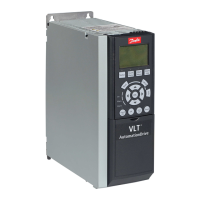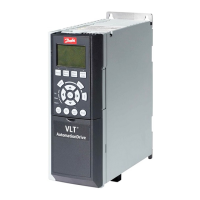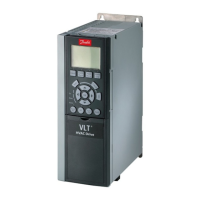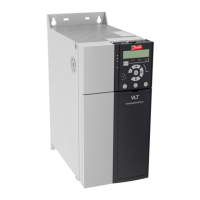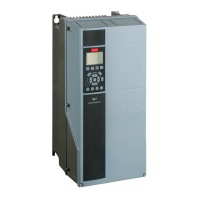3.4.5 Tuning Speed PID Control
The following tuning guidelines are relevant when using one of the flux motor control principles in applications where the
load is mainly inertial (with a low amount of friction).
The value of 30-83 Speed PID Proportional Gain is dependent on the combined inertia of the motor and load. The selected
bandwidth can be calculated using the following formula:
Par
. 7− 02 =
Total
inertia
kgm
2
x
par
. 1− 25
Par
. 1− 20
x
9550
x
Bandwidth
rad
/
s
NOTICE!
1-20 Motor Power [kW] is the motor power in kilowatts. For example, enter ‘4’ kW instead of ‘4000’ W in the formula.
A practical value for the bandwidth is 20 rad/s. Check the result of the 30-83 Speed PID Proportional Gain calculation against
the following formula. This is not required if using a high resolution feedback such as a SinCos feedback.
Par
. 7− 02
MAX
=
0.01
x
4
x
Encoder
Resolution
x
Par
. 7− 06
2
x
π
x
Max
torque
ripple
%
A good starting value for 7-06 Speed PID Lowpass Filter Time is 5 ms. A lower encoder resolution calls for a higher filter
value. Typically a max torque ripple of 3% is acceptable. For incremental encoders, the Encoder Resolution is found in either
5-70 Term 32/33 Pulses Per Revolution (24 V HTL on standard drive) or 17-11 Resolution (PPR) (5 V TTL on MCB102 Option).
Generally the practical maximum limit of 30-83 Speed PID Proportional Gain is determined by the encoder resolution and the
feedback filter time, but other factors in the application might limit the 30-83 Speed PID Proportional Gain to a lower value.
To minimize the overshoot, 7-03 Speed PID Integral Time could be set to approx. 2.5 s. Time varies with the application.
7-04 Speed PID Differentiation Time should be set to 0 until everything else is tuned. If necessary, finish the tuning by
adjusting this setting in small increments.
Product Introduction Design Guide
40 Danfoss A/S © Rev. 2014-02-10 All rights reserved. MG34S222
33

